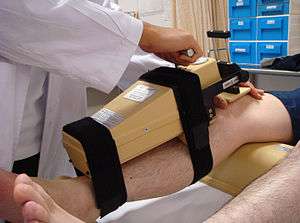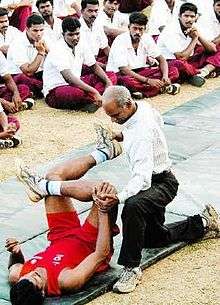Sports medicine
 Orthopaedics is a large part of sports medicine, and knee injuries a common theme. Here a subject is having the anterior-posterior laxity of his knee tested. | |
| System | Musculoskeletal, Cardiovascular |
|---|---|
| Focus | |
| Significant diseases | |
| Significant tests | Musculoskeletal tests |
| Specialist | Sports physician |
| Glossary | Glossary of medicine |
Sports medicine is a branch of medicine that deals with physical fitness and the treatment and prevention of injuries related to sports and exercise. Although most sports teams have employed team physicians for many years, it is only since the late 20th century that sports medicine has emerged as a distinct field of health care.
Scope
Medicine doctors are specialist physicians who have completed medical school, appropriate residency training and then specialize further in sports medicine or 'sports and exercise medicine' (the preferred term). Specialization in sports medicine may be a doctor's first specialty (as in Australia, Netherlands, Norway, Italy). It may also be a sub-specialty or second specialisation following a specialisation such as physiatry, family medicine, paediatrics or orthopedic surgery. The various approaches reflect the medical culture in different countries.
Specializing in the treatment of athletes and other physically active individuals, sports and exercise medicine physicians have extensive education in musculoskeletal medicine. SEM doctors treat injuries such as muscle, ligament, tendon and bone problems, but may also treat chronic illnesses that can affect physical performance, such as asthma and diabetes. SEM doctors also advise on managing and preventing injuries.
SEM consultants also deliver clinical physical activity interventions, negating the burden of disease directly attributable to physical inactivity and the compelling evidence for the effectiveness of exercise in the primary, secondary and tertiary prevention of disease.

Exercise medicine
The Foresight Report[1] issued by the UK's Government Office for Science, 17 October 2007, highlighted the unsustainable health and economic costs of a nation that continues to be largely sedentary. It forecasts that the incremental costs of this inactivity will be $10 billion per year by 2050 and the wider costs to society and businesses $49.9 billion. Physical inactivity inevitably leads to ill-health and it forecasts the cost of paying for this impact will be unsustainable in the future. No existing group of medical specialists is equipped with the skills and training to deal with this challenge.
Public health
SEM physicians are frequently involved in promoting the therapeutic benefits of physical activity, exercise and sport for the individuals and communities. SEM Physicians in the UK spend a period of their training in public health, and advise public health physicians on matters relating to physical activity promotion. An example of published work includes the Royal College of Physicians publications.
Common sports injuries
Some of the more common sport injuries are concussions, muscle cramps, ACL sprains, ACL tears, ankle sprains, shin splints, muscle strains, etc...
History
In recent years Western society has increasingly recognized the dangers of physical inactivity, and significant efforts have been made within the public health community to encourage the nation to become more physically active. To reflect this paradigm shift BASM has renamed itself BASEM (British Association of Sport and Exercise Medicine) and the speciality itself has rebranded from Sports Medicine to Sport & Exercise Medicine.[2] Since 2007 several deaneries across the UK have established training programmes in SEM, and recurrent funding for 50 National Training Numbers (NTN's) is available.
Organizations
- American College of Sports Medicine (ACSM) Founded in 1954, the American College of Sports Medicine is the largest and most prominent sports medicine and exercise science organization in the world. ACSM has more than 45,000 International, National and Regional Chapter members.[3]
- American Orthopaedic Society for Sports Medicine (AOSSM) The American Orthopaedic Society for Sports Medicine is a world leader in sports medicine education, research, communication, and fellowship. Founded in 1972, AOSSM is an international organization of orthopaedic surgeons and other allied health professionals dedicated to sports medicine. Essentially every professional and collegiate team has a team physician who is a member of the AOSSM.[4]
- American Medical Society for Sports Medicine (AMSSM) AMSSM is a multi-disciplinary organization of sports medicine physicians dedicated to education, research, advocacy and the care of athletes of all ages. The majority of AMSSM members are primary care physicians with fellowship training and added qualification in sports medicine who then combine their practice of sports medicine with their primary specialty. AMSSM includes members who specialize solely in non-surgical sports medicine and serve as team physicians at the youth level, NCAA, NFL, MLB, NBA, WNBA, MLS and NHL, as well as with Olympic teams. By nature of their training and experience, sports medicine physicians are ideally suited to provide comprehensive medical care for athletes, sports teams or active individuals who are simply looking to maintain a healthy lifestyle.[5]
- National Athletic Trainers' Association (NATA) Founded in 1950, the mission of the National Athletic Trainers Association is to enhance the quality of health care provided by certified athletic trainers and to advance the athletic training profession.
- Canadian Athletic Therapists' Association (CATA) Founded in 1965.[6] The Canadian Athletic Therapists Association (CATA) is an organization devoted to the comprehensive health care of an individual at any level of physical ability by Certified Athletic Therapists.
- American Medical Association (AMA) The American Medical Association recognized Athletic Training(AT) as an allied health profession in 1990.[7]
- International Society of Arthroscopy, Knee Surgery and Sports Medicine (ISAKOS) The ISAKOS - International Society of Arthroscopy, Knee Surgery and Orthopaedic Sports Medicine is an international society with over 4,000 surgeons members, dedicated to advancing of education, research and patient care in arthroscopy, knee surgery and orthopaedic sports medicine around the world.
- International Association for Dance Medicine and Science (IADMS) The International Association for Dance Medicine & Science was formed in 1990 by an international group of dance medicine practitioners, dance educators, dance scientists, and dancers. Membership is drawn equally from the medical and dance professions, and has grown from an initial 48 members in 1991 to over 900 members at present worldwide, representing 35 countries.
See also
- Athletic trainer
- Canadian Athletic Therapists Association
- Exercise
- Exercise physiology
- Ice bath
- Nutrition
- Overtraining
- Dan Tunstall Pedoe
- Physical fitness
- Physical therapy
- Physiatry
- Sports chiropractic
- Sports injuries
- Sports nutrition
- Sports science
- Sports training
- Augustus Thorndike
- Tommy John surgery
- Ventricular hypertrophy
References
| Wikimedia Commons has media related to Sports medicine. |
- ↑ Government Office for Science – GOV.UK. Foresight.gov.uk. Retrieved on 2016-10-06.
- ↑ Health through sport and exercise. Faculty of Sport and Exercise Medicine.
- ↑ "Why ACSM?". American College of Sports Medicine. Retrieved 19 September 2013.
- ↑ Inc., Advanced Solutions International,. "Our Mission". www.sportsmed.org. Retrieved 2018-09-05.
- ↑ "ABOUT AMSSM". www.amssm.org. Retrieved 2018-09-05.
- ↑ De Conde, C. (1990). The CATA – A Historical Perspective. The Journal of the Canadian Athletic Therapists' Association, 6–10.
- ↑ "Athletic Trainers". Explore Health Careers. Retrieved 20 September 2013.
Further reading
- Lois Reynolds; Tilli Tansey, eds. (2009), The Development of Sports Medicine in Twentieth-century Britain, Wellcome Witnesses to Contemporary Medicine, History of Modern Biomedicine Research Group, ISBN 978-0-85484-121-9 , Wikidata Q29581766